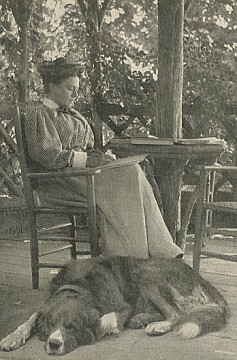Mabel Osgood Wright (1859-1934)
Author, Conservationist & 1st President of the Connecticut Audubon Society
She was born at her parents' house that still stands today at 154 West 11th Street, New York City, and grew up between there and "Mosswood" her father's 18-room house at Fairfield, Connecticut. On first glance, it might appear that she was related to U.S Postmaster-General Samuel Osgood, but in fact they came from two quite separate families. Mabel was brought up in a culturally stimulating household, her father being close friends with the likes of William Cullen Bryant, Oliver Wendell Holmes, J.P. Morgan, and George Bancroft, and she often went with him to lectures at the New-York Historical Society. In 1884, she married an Englishman who had set himself up in New York City as a dealer in rare books, prints, etc. After an extended trip to England, they settled permanently in Fairfield, Connecticut, giving rise to her husband's pseudonym, "the commuter," to whom she often referred to and wrote about in her books.
She was encouraged by her father and her husband to pursue a literary career over her original wish to attend medical school at Cornell. After publishing her first book in 1894 she studied at the American Museum of Natural History which resulted in her second book, Birdcraft, an early field guide that was described by Frank Chapman as, "one of the first and most successful bird manuals". She was a co-founder and the first President of the Connecticut Audubon Society (1898-1924); Director of the National Audubon Society; Associate Member of the American Ornithologists Union (one of the first three elected women); and, backed by her wealthy friend Annie Burr Jennings, was the creator of the Birdcraft Sanctuary at Fairfield - the oldest private songbird sanctuary in the States. As a member of the Connecticut Society of Colonial Dames, she rather scorned the Daughters of the American Revolution who she ridiculed in her book, A Woman Errant (1904).
As a writer, she was almost entirely inspired by her garden at Fairfield. Having become well-known for her books for adults and children on nature and outdoor life, when she began to write fiction she used the pseudonym "Barbara" (referring to her husband as "Evan") until they won independent recognition. Her most popular books were semi-autobiographical, notably The Garden of a Commuter's Wife (1901) in which she first introduced her alter-ego, "Barbara". In these books (nb. Princess Flower-Hat), aside from introducing the reader to a host of comical, eccentric friends, she also showed herself to be a keen observer of the changes taking place in society. In her lifetime, she authored more than two dozen works of fiction and non-fiction, including her autobiography, My New York (1926), that was described as, "a beautifully written picture of life in Lower Manhattan in the 1860s and 1870s". She died at "Mosswood" without children in 1934.
She was encouraged by her father and her husband to pursue a literary career over her original wish to attend medical school at Cornell. After publishing her first book in 1894 she studied at the American Museum of Natural History which resulted in her second book, Birdcraft, an early field guide that was described by Frank Chapman as, "one of the first and most successful bird manuals". She was a co-founder and the first President of the Connecticut Audubon Society (1898-1924); Director of the National Audubon Society; Associate Member of the American Ornithologists Union (one of the first three elected women); and, backed by her wealthy friend Annie Burr Jennings, was the creator of the Birdcraft Sanctuary at Fairfield - the oldest private songbird sanctuary in the States. As a member of the Connecticut Society of Colonial Dames, she rather scorned the Daughters of the American Revolution who she ridiculed in her book, A Woman Errant (1904).
As a writer, she was almost entirely inspired by her garden at Fairfield. Having become well-known for her books for adults and children on nature and outdoor life, when she began to write fiction she used the pseudonym "Barbara" (referring to her husband as "Evan") until they won independent recognition. Her most popular books were semi-autobiographical, notably The Garden of a Commuter's Wife (1901) in which she first introduced her alter-ego, "Barbara". In these books (nb. Princess Flower-Hat), aside from introducing the reader to a host of comical, eccentric friends, she also showed herself to be a keen observer of the changes taking place in society. In her lifetime, she authored more than two dozen works of fiction and non-fiction, including her autobiography, My New York (1926), that was described as, "a beautifully written picture of life in Lower Manhattan in the 1860s and 1870s". She died at "Mosswood" without children in 1934.



